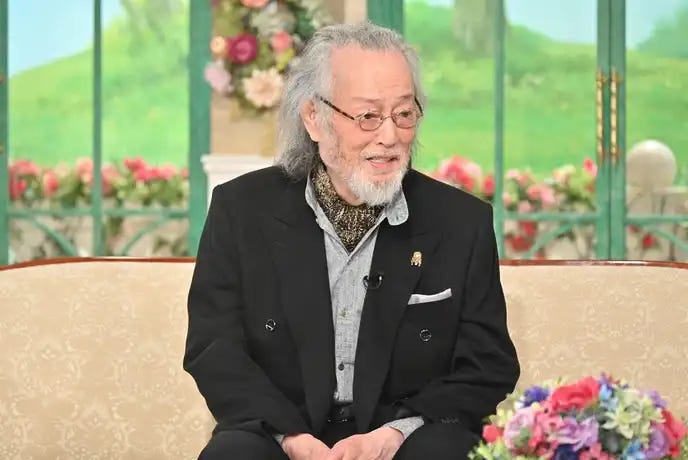Foreign Perspectives is a mix of free and paid content. Certain columns such as these are free for all subscribers, but other articles will be exclusive for paid subscribers. If you enjoy the work I do, please consider upgrading to a monthly or yearly subscription. Your support is greatly appreciated and ensures that this Substack can continue to deliver high quality pieces.
About ten minutes into Seven Samurai, one can see a young man walking through the streets of a bustling town. He is clearly a samurai, but not one of the titular main warriors in Akira Kurosawa’s jidaigeki epic. The character is nameless and unimportant the story; a mere blink-and-you’ll-miss-him background extra no one in 1954 would have paid attention to. Yet just a few years later, the man playing him would become known throughout Japan as Tatsuya Nakadai and later acknowledged worldwide as one of his country’s finest actors.
Over the next seven decades, Nakadai worked with Kurosawa again multiple times, as well as other acclaimed directors like Masaki Kobayashi and Keisuke Kinoshita. He acted alongside multiple generations of acclaimed Japanese actors from Toshiro Mifune to Hiroyuki Sanada, while also starring in Japanese stage adaptations of William Shakespeare and Arthur Miller well into his twilight years. Few Japanese performers from the mid-20th century successfully transitioned into the 21st, but Nakadai continued his appearances in film, television, and plays long after most of his contemporaries retired or passed away.
If one looks at most of the films Nakadai appeared in, he was often the sole surviving principle cast member due to him starting his career young and never ceasing to be prolific. Sadly, it was announced this month that Tatsuya Nakadai died of pneumonia at the age of 92 on Nov. 8, 2025. Among the last of Japan’s dwindling generation of silver screen icons who lived through World War II, his passing truly marks the end of an era. I’m not in the habit of writing many obituaries, but this is one of the few occasions I feel compelled to do so.
Western audiences will probably best remember Nakadai for playing opposite Toshiro Mifune in the Akira Kurosawa pictures Yojimbo, Sanjuro, and High and Low. Those films are stunning examples of his fidelity as an actor, skillfully pulling off roles from slick police inspectors to Edo era gun-toting gangsters. When Kurosawa turned him into the protagonist of his later jidaigeki films Kagemusha and Ran, Nakadai brought forth a powerful presence that commanded attention and made ancient Japan feel like a living, breathing place with human characters reminding us of our modern foibles.
Even more than his Kurosawa collaborations, my favorite films of Nakadai’s were the ones he did with Masaki Kobayashi. At the age of 27, he carried the entirety of The Human Condition trilogy released between 1959 and 1961. This nine-and-a-half-hour epic saga followed the tragic story of a Japanese idealist who begins World War II as a well-meaning, but naive labor chief of Chinese slaves in Manchuria to becoming a prisoner himself in the desolate Soviet POW camps of Siberia. It was a complex role that most older actors would struggle with, but Nakadai’s youth and commitment proved to be his assets.

Perhaps Nakadai’s best performance was in Harakiri, Kobayashi’s bitter attack on idealized views of the samurai class and a greater commentary on the dangers of dogmatic systems. The protagonist is a wandering ronin with a tragic backstory that slowly unfolds throughout the course of the narrative. What makes it all the more incredible is that despite Nakadai only being 29 at the time of filming, he convincingly plays a middle-aged samurai with an aura of bitter world weariness. The verbal back-and-forth he has with the antagonist played by Rentaro Mikuni proves to be just as thrilling as the film’s sword duels. To anyone wanting to get into Nakadai’s work for the first time, Harakiri is the place to start.
Despite these deadly serious roles, Nakadai off screen was described as one of the most approachable actors in the industry. He was known to be a practical joker when the cameras were not rolling and regularly made his co-stars laugh with humorous impressions. Not all his characters were fierce warriors or tormented lords, either. In the heartbreaking drama about Hachiko, Nakadai showed his warmer side as the loyal Akita dog’s departed owner. He even lent his voice for a few anime films like Belladonna of Sadness and The Tale of the Princess Kaguya.

With over 160 films to his name, seemingly no role was too challenging for Nakadai to undertake. Whether his characters required physical action, deep pathos, lighthearted comedy, or a smooth tongue, it was practically guaranteed to be a knockout performance and often became the highlight of the entire picture. He was the kind of old-school Japanese movie star that no longer exists today. Tatsuya Nakadai’s passing closes a chapter, but what he contributed to cinema will live on for ages.
Foreign Perspectives is a reader-supported Substack. If you like my work and have come this far, consider opting for a paid subscription so I can continue writing in-depth articles such as these on a regular basis. Your support is greatly appreciated!




